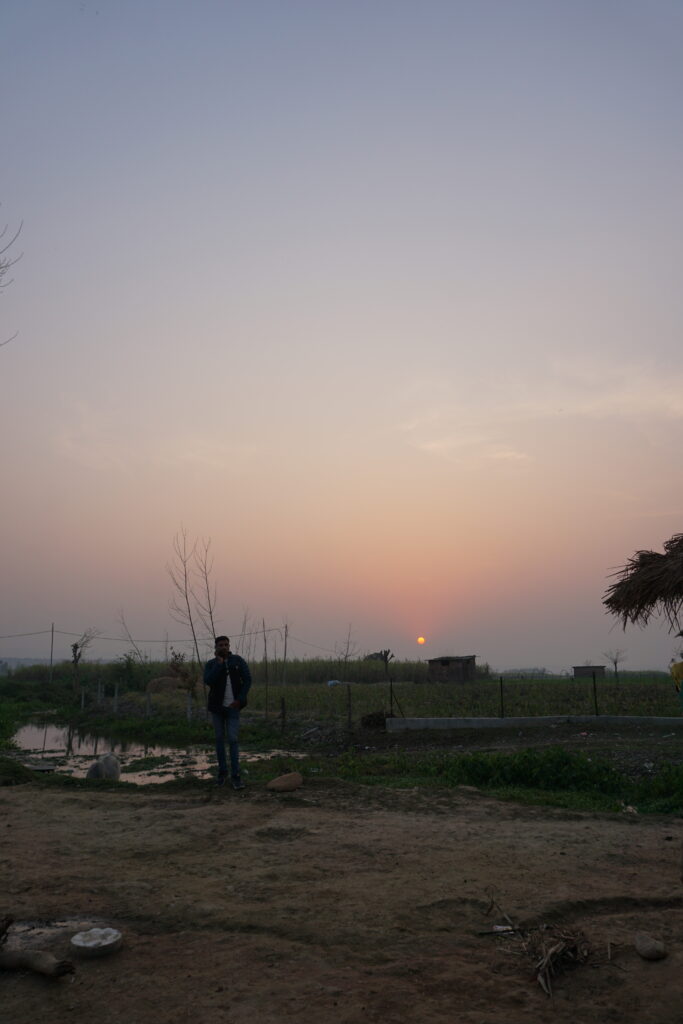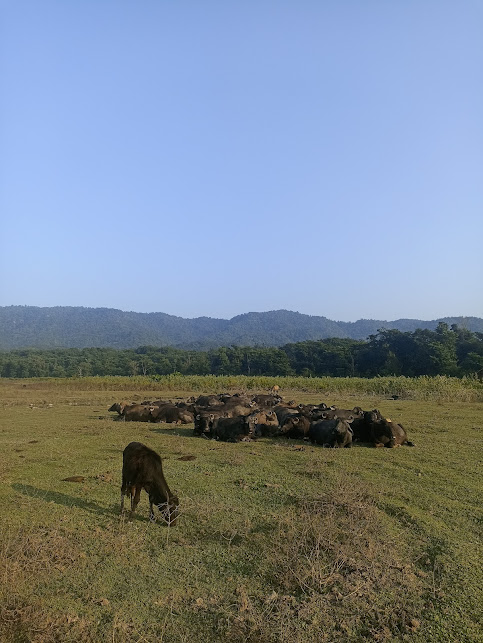Winters are here and at the start of December, all the colorful kambals (coarse woolen blanket or shawl) are out. Days are short and people get done with their dinners early. More cups of steamy tea are consumed while sitting arond the fireplace. During the evenings, one can also see Mais (one who takes the buffaloes to the jungle) cutting leaves for Gojri buffalo.
I recently shifted to Kunao, a small village near Rajaji National Park in Rishikesh, Uttarakhand. Here all my mornings have been beautiful. Every sunrise unravels new truths. At the very beginning, a light orange line appears on the horizon in between cold darkness. This line then starts getting thicker and thicker. Eventually dividing itself into different shades of exciting orange. No one can see the outlines of trees and hills. Although the figures, objects around are still black. It is still time for the glowing ball to appear in the sky and spread life. These are just pre-arrangements.
This thick multicolored line has started melting in the sky producing various shades of red, pink, orange, and white. The overlapping sky has turned into light navy blue as it steps aside almost like the darkness taking a backseat to look at the drama. As the mixture starts hosting magical colors, objects in the front appear more clearly, they have a shape and size with cold tints and a smoky mist acting as a wrapping over the morning.
These shades then start becoming stronger in the sky. These fading colors mix together to become one deep orange. The orange color then takes up the whole sky announcing the arrival. Soon the hills, ranges, trees, school, pets, animals, birds, and I, all hold our colors to welcome His Highness who will bless us and spread life on this cold, blue land. Everyone worships Him and that’s why this place is called the city of saints maybe – Rishikesh.
I want to bottle these sunrises and sunsets and conserve them as my city friends are not lucky enough to experience it.

The more I stay here, the more I realize how beautiful life can be.
Decentralization was an unachievable and impractical concept for me. But now, after looking at these Van Gujjar (nomadic pastoral tribe) settlements and their strategic divisions of commons which is carried out for generations I believe it’s not just possible but the only solution to avoid the overburdening and destruction of public resources.

In my understanding, the Van Gujjar settlement needs large amounts of grazing land nearby and moving water resources, and a fruitful jungle with a lot of tasty trees for the gojris.
A Gujjar then makes a small blockage over the flowing water for his gojri buffalo so she can rest in these ponds. This also becomes a source of water for her and other wild animals. Slowly some grasses grow around these ponds inviting bugs, frogs, and birds.
These ponds become necessities during summer as many animals reach the border of the Rajaji National Park in search of water, especially elephants. Aftab, from Kunao Choud was talking about one such summer when an elephant fell into the canal, got carried with the water for a long time. And then somehow got out from a broken patch. He then added that often buffalos fell in the canal while coming back from grazing. And how they had to retrieve them. This incident made me question, How come everything we have made is exclusive when the form in which we got it was so inclusive ?
As it gets hotter in summer, then comes the time to migrate higher up to the Himalayan regions on foot with their families and gojris. One can see the happiness in the smiles on people faces when they start packing. All the while singing “Pahad jane ka waqt aa gaya”. Nowadays not everyone leaves home, a member or couple stays back to take care of old parents. There are Beyts (songs) about these young brothers who choose to stay back, as they are dearly missed in the journey.
They come back to the plains when the monsoons are about to end. One can see the color of Ganga changing during this time. In another magical transition, the water turns from playful brown to a calm tint of turquoise. Ganga truly looks like some divine Goddess, calming the body and souls who have struggled during monsoons and have lost their buffaloes to the highway while coming down.
Gujjars are back home. They have settled down and have started preparations for winters. Now the jungle will play a bigger role than just a home. It’s time to cut pattis for gojri. It is one of the most difficult periods for the buffalos as after a point, pattis are not enough to feed the herd. Van Gujjars now have to gather and store pural (a substitute fodder) from farmers which is expensive. It also has to be transported to that Khatta (another Van Gujjar settlement) and then taken to the dera (hut in which they stay). There are plenty of ghaas (grass) that gojri buffaloes like from the mountain ranges nearby but the Forest Department does not allow the transportation of these ghaas. They think that the Gujjars take it from here and sell it in the market.
Winter nights are harsh and buffaloes who do not travel to the Alpines (higher altitudes) and are used to maidans (grasslands) are less resistant to cold. The Oos (dew) on their backs make them sick sometimes.
In this, the sun is a big relief. In Kunao village, sunshine blesses these humble creatures with a whole day of warm rays. The Sun also heats up the land and grass where the buffaloes sit and relax most of the time of day.

In the early days, winter was the mating period for gojri buffalos. But in recent times because of climate change, it has now shifted to April – June. It is still interesting to observe how a pastoralist faces these changes. First, the cattles adapt to the new climate and then the Van Gujjars accommodate it in their living.
These cycles go on and on with all the new factors adding up. But sometimes situations change drastically. One can see with Van Gujjars who were resettled. Here the Gujjars sold their buffaloes and tried their luck in farming. But it did not work. And they are now buying their buffaloes again. Not just for economic gains but because the love for gojris is hard to let go of. All they know is how to take care of their buffaloes hence the need to bring them back.
This cycle of the Gujjars and gojris continues over years, without any disturbance. Time comes and goes and Gujjars keep practicing this beautiful relation of co-existence, with or without any acceptance of the world. Everything else does not matters. What matters to them is their bhaais (buffalo). It’s truly wonderful to see how that relation helps everything around it bloom with love.





0 Comments